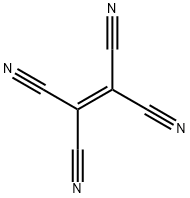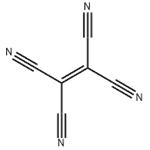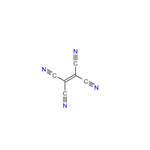Tetracyanoethylene (TCNE) is a crystalline solid with a melting point of 200 °C. DuPont researchers prepared it in 1957 by treating dibromomalononitrile with copper in boiling benzene. TCNE is an excellent electron acceptor and has been used to prepare organic superconductors.
Tetracyanoethylene is a chemical compound of cyanide. It is used to prepare numerous organic superconductors, usually by serving as a single electron oxidant of an organic electron donor. Such charge-transfer salts are sometimes called Bechgaard salt.
white to beige-brown crystalline powder, crystals. Tetracyanoethylene [670-54-2], ethenetetracarbonitrile, TCNE, ( NC)2C = C (CN)2, Mr 128.09, mp 197 – 198℃, bp 223℃, n25 D 1.560. The preferred synthetic preparation of TCNE involves the debromination of the KBr complex of dibromomalononitrile. Tetracyanoethylene is a reactive compound that undergoes a variety of reactions including addition, replacement and cyclization. The chemistry of TCNE is exhaustively reviewed in.
In the synthesis of spiro Compounds, in modified Diels-Alder reactions, as aromatizing agent: Longone, Smith, Tetrahedron Lett. 1962, 205.
Used for postfunctional addition to polyphenylacetylene derivatives to change the oxygen permeability
Reactant for:
- Regioselective [2+2] cycloaddition reaction for production of BODIPY dyes and TCBD derivatives
- Thermal addition reaction with alkynes
- One-pot reactions with nucleophilic reagents forming aromatic cyanovinyl compounds
- Synthesis of cobalt tetracyanoethylene films
- Biotransformation by Botrytis cinerea
The first member
of a class of compounds called cyanocarbons.
Organic Syntheses, Coll. Vol. 4, p. 877, 1963
The Journal of Organic Chemistry, 45, p. 5113, 1980
DOI: 10.1021/jo01313a019
Hydrolyzes in moist air to hydrogen
cyanide.
Crystallise it from chlorobenzene, dichloroethane, or dichloromethane [Hall et al. J Org Chem 52 5528 1987]. Storeitat0oina desiccator over NaOH pellets. (It slowly evolves HCN on exposure to moist air CARE.) It can also be sublimed at 120o under vacuum. Also purify it by repeated sublimation at 120-130o/0.5mm. [Frey et al. J Am Chem Soc 107 748 1985, Traylor & Miksztal J Am Chem Soc 109 2778 1987, Fatiadi Synthesis 249 1986, Synthesis 749 1967, Beilstein 2 IV 1245.]



